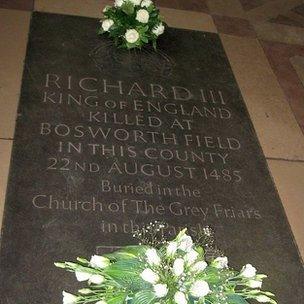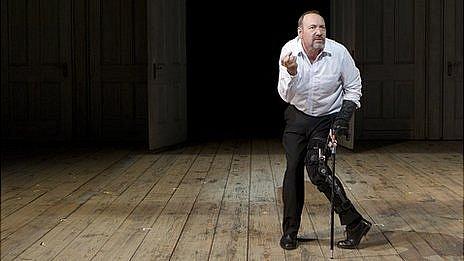Richard III dig: Mysteries remain over notorious king
- Published

Richard's hopes of establishing a stable ruling dynasty were destroyed by the deaths of his wife and only legitimate son
The image of a Shakespearean gargoyle is propaganda, they say, and the records prove he was no rapacious villain.
But even Richard's most ardent supporters cannot deny he died betrayed and isolated, overwhelmed by the second rebellion of his short reign.
From loyal brother of a king and protector of royal children, to buried in a forgotten grave and reviled as a historical bogeyman - where did it all go wrong for Richard III?
His early life illustrated the crucible which England in the 15th Century had become, with decades of warfare tearing families apart.
'Powder keg'
He was eight when his father Richard of York and brother Edmund died in battle and he spent two periods in exile abroad.

A memorial to the missing king was placed in Leicester Cathedral
But when his brother Edward IV was restored to the throne in 1471, Richard began to build a reputation as a formidable power player.
Lynda Pidgeon, research officer for The Richard III Society, explained: "He had fought for his brother and proved his loyalty during the hard times.
"Once installed as the Duke of Gloucester, he managed the north of England very efficiently. He set up a council to represent the interests of the area, organising troops to deal with the Scots.
"He took care of his people, he had made a lot of religious donations and tried to make sure all of those living in the wilds of Yorkshire had access to a good, educated priest.
"It was not just about the nobles, he looked after the poor people."
Power struggle
The unexpected death of Edward IV in 1483 changed the balance of power.
Ms Pidgeon said: "In some ways this is where it starts to go wrong. Edward's heir, also called Edward, is just 12 years old which makes his grasp on power uncertain.
"Add to that the new king's mother, and her family the Woodvilles, are hungry for power. All this in a land which has seen decades of changing loyalties and rivalries.
"Richard was sitting on a powder keg."
In the ensuing power struggle, Richard had several nobles executed and placed Edward V and his younger brother in the Tower of London, a secure royal residence.
Within days, doubts about the legitimacy of the two princes were proclaimed and Richard was offered the crown.
Double blow
Dr John Ashdown-Hill, the author of a book about the last days of Richard, said: "This was not a straightforward succession.
"While I think Richard was the rightful heir because his brother's children were illegitimate, there was some upset over the passage of the crown to Richard.
"Some people will have viewed him as someone ready to be ousted."
Ms Pidgeon said: "This led to a split between those who supported the family of Edward IV and those who saw Richard as the more legitimate and more capable leader.
"And of course there are lots of shifting allegiances with people thinking of what is best for them, usually in terms of land and money."
Richard was crowned 6 July 1483, a move backed by Parliament.

Shakespeare completed a smear campaign vital to the Tudor dynasty's grip on power, Richard's supporters believe
But then his reign suffered two setbacks. Firstly rumours about the fate of the princes in the tower, who had not been seen for some time, began to circulate, creating popular ill feeling.
Then Richard's only legitimate son died, followed soon after by his wife. This destroyed any promise of dynastic stability.
A former ally, the Duke of Buckingham, led a short-lived rebellion in 1483 but its destruction failed to deter another challenger.
Ms Pidgeon said: "When Richard faced Henry Tudor at Bosworth, they both had a core of supporters but around that is a shifting mass of nobles who are waiting to see which way the wind blows.
"Richard trusted people he shouldn't have trusted. The Earl of Northumberland, who should have supported the king, somehow never managed to get in the battle and of course it was the Stanleys who decisively joined in on Henry's side."
Damned legacy
His death was only the start of the punishment handed out to Richard.
Dr Ashdown-Hill said: "It is normal for a defeated leader to be rubbished by the political enemies who take over from him, but in this case it was vital for Henry VII that this should be done because Richard's claim to the throne was impeccable and Henry VII's was very weak.
"Henry tried to strengthen his position by marrying Edward IV's daughter but also by painting Richard as the villain of the piece.
"No-one knew what had happened to the princes in the tower who - if they were still alive - would have been a serious challenge to Henry's throne.
"By naming Richard as their killer, Henry VII killed two birds with one stone.
"Tudor historians created ever more ghoulish portrayals of the former king, accounts which Shakespeare turned into popular myth."
- Published12 September 2012
- Published12 September 2012
- Published8 September 2012